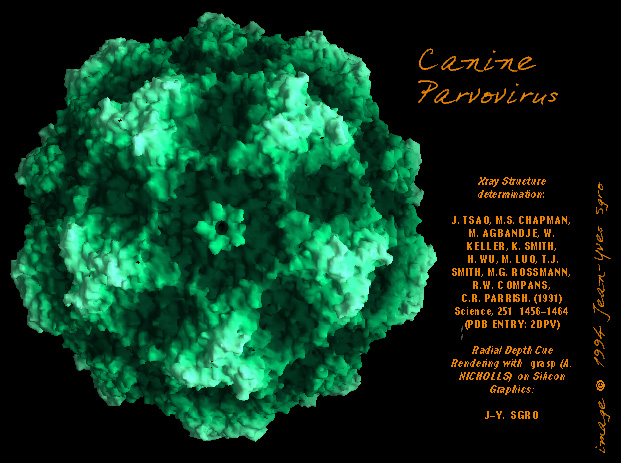
Molecular surface, radially depth cued, as solved by X-ray crystallography
from the Institute for Molecular Virology - Wisconsin.
http://www.virology.net/Big_Virology/BVDNAparvo.html

Molecular surface, radially depth cued, as solved by X-ray crystallography
from the Institute for Molecular Virology - Wisconsin.
http://www.virology.net/Big_Virology/BVDNAparvo.html
General Information
Canine Parvovirus (CPV) was first observed
in 1978, and is considered a completely new pathogen for dogs. No
conclusive origin of CPV is known, but it is postulated that CPV arose
by natural genetic mutations of the feline panleukopenia virus (FPLV).
CPV and FPLV are more than 98% similar in nucleotide and amino acid sequence,
but they can be easily be distinguished from each other based on biological
properties. These biological differences translate into very minor
genetic differences, however, as analysis has shown that even a difference
as significant as the canine host range is determined by a three or four
sequence difference in the viral protein gene. CPV is an important
example of virus shift in host range and is being studied as a possible
model for how new viruses originate.
When CPV first surfaced in the 1970s,
it caused a wide-spread epidemic amongst wild and domestic canines,
resulting in the death of thousands of animals. Although CPV is now
seen considerably less, outbreaks still occur. The virus is especially
a risk to puppies that are less than 6 months old and older dogs.
CPV is usually spread from dog-to-dog
by direct or indirect contact with infected fecal matter. Most cases of
parvovirus infection occur where dogs assemble, such as parks, dog shows,
kennels, pet shops, etc. People may also contribute to the spread
of CPV by carrying infected fecal matter on their shoes. CPV infection
can easily occur in any dog since the virus is highly infectious and hardy,
withstanding a wide range of temperatures and surviving outside the animal
for months. Infected dogs may shed virus for up to 18 days after exposure
without showing any symptoms of disease, which also contributes to the
spread of CPV.
The incubation period is about 5-7
days, until the onset of symptoms.
Canine parvovirus is an intestinal
disease. The virus has an affinity for mitotically active cells, and it
is capable of replicating in a large number of tissues in neonatal animals.
CPV may infect the hearts of neonatal pups causing myocarditis. In
older animals, the virus replicates primarily in the primary and secondary
lymphoid tissues, as well as the in the replicating cells of the small
intestinal crypts.
Infection with CPV can be silent.
In instances of disease, symptoms include loss of appetite, depression,
elevated fever, massive dehydration, lethargy, diarrhea and vomiting. Diarrhea
may be bloody and the vomiting may be severe and repeated. The disease
can cause rapid death, and may result in intestinal and heart damage in
surviving animals. Dogs who successfully recover from infection develop
immunity to subsequent CPV infection.
A live canine parvovirus vaccine is
available, and initial and follow-up vaccination for young puppies is considered
critical. Yearly booster vaccinations should be adequate for protecting
adult dogs.
There is no cure for parvovirus, and treatment
may be difficult. Intravenous fluids and electrolytes are provided to counteract
dehydration, medication is given to relieve intestinal cramping, and antibiotics
are given to prevent secondary bacterial infection.
The best way to prevent CPV is to
promote annual vaccination and to clean any potentially contaminated areas
with chlorine bleach.
Humane
Society info page on CPV